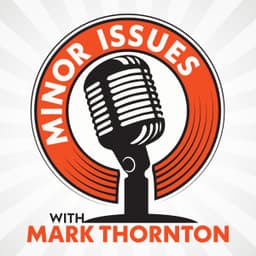
Minor Issues
Succinct economic commentary by Dr. Mark Thornton, senior fellow at the Mises Institute.
10

Minor Issues, Major Conversations: Mark Thornton’s Four-Interview Roundup
<p>On this marathon episode of Minor Issues, Mark stitches together four recent interviews for a fast-moving tour of today’s economy: why gold spiked while precious metals whipsawed, how ballooning US debt and rising servicing costs tilt policy toward monetization, and what that means for inflation, markets, and families. Along the way Mark explains the Austrian lens behind his calls and why using it beats siloed, headline-driven takes.</p><p>Highlights include: the recent precious metals pullback and what to watch next; the mechanics of debt monetization; distributional effects that favor asset holders over wage earners; and why hyperinflation ri...

Silver: Manipulation or Fundamentals?
<p>Is silver “manipulated,” or are fundamentals doing the work? Mark Thornton sifts the evidence and finds a simpler story. Big players have gamed markets before, but the long arc of silver prices reflects structural forces: the 1960s demonetization that pushed vast coin hoards into private stockpiles, decades of shifting industrial demand, and the rise of by-product mining. Add environmental compliance and hard-to-recycle “green” uses that sequester silver, and the result is stubbornly low real prices.</p><p>Be sure to follow Minor Issues at https://Mises.org/MinorIssues</p>

Nothing Good Starts at the Top
<p>Speaking at the recent Mises Institute Supporters Summit, Mark Thornton argues that lasting reform comes from the bottom up, not from political edict. Drawing on Hayek’s “worst get to the top” insight, Mark contrasts elite-driven prohibition with the citizen-led wave of decriminalization and legalization across states and abroad. Mark also explains the role of “salutary neglect” by local officials, the Oregon backlash as a failure of property-rights enforcement—not of liberty—and the scholarly case against the drug war. The crux: markets and civil society integrate; top-down policy divides.</p><p>Be sure to follow Minor Issues at https://Mises...

Reading Markets the Austrian Way
<p>Mark Thornton reviews David Howden’s data-driven guide to long-horizon investing in commodities, useful even for Austrians wary of statistics. Mark explains how the book’s method ranks assets by relative valuation, generates 10-year return forecasts, and frames risk premiums, using gold and silver as case studies. Mark highlights how a formal model can still complement Austrian fundamentals and capital-allocation thinking, and he previews an upcoming episode on silver that will build on these results.</p><p>Purchase The Almanac of Commodities by David Howden at http://mises.org/almanac</p><p>Be sure to follow Minor Issues at http...

Silver’s $50 Moment
<p>Mark Thornton shares a timely conversation from the Liberty & Finance podcast with Elijah K. Johnson. Mark explains why $50 silver is a psychological barrier, and how decades of tech shifts, by-product mining, and central-bank gold buying shaped today’s divergence between gold and silver. The thread tying it all together: easy money seeds malinvestment and fragility; metals hedge the fallout.</p><p>Be sure to follow Minor Issues at https://Mises.org/MinorIssues</p>

Monetary Metals 101: How Gold and Silver Work in a Free Market
<p>Mark Thornton lays the groundwork for understanding gold and silver before politics gets involved. Mark explains why monetary metals emerge from market “evolution,” how their non-consumptive use creates massive above-ground stocks, and why the same metal serves multiple markets (money vs. consumption) with one price. He explains how demand shifts trigger conservation and recycling, why new mining lags price spikes, how “near-monies” substitute when people economize on cash balances, and why any apparent stability (even par relationships) reflects underlying market conditions, not decree. Today’s price volatility is largely the artifact of intervention, not the metals themselves.</p><p>Be sure to...

Vitamins vs. Technocracy: Lessons from MK-7
<p>On the latest episode of Minor Issues, Mark Thornton uses vitamin K2 (MK-7) as a case study in how technocracy goes wrong, elevating cutting-edge findings and bureaucracy over experience, incentives, and real-world diets. Mark explains why K2 is linked in emerging research to bone health, arterial calcification, and even neurodegenerative conditions, and highlights a paradox: many food sources rich in K2 (beef, eggs, butter, chicken liver, European cheeses, salami) are officially discouraged, while “approved” sources (natto, kefir, sauerkraut) are niche. The takeaway isn’t medical advice, it’s a critique of a compliance-driven health regime that sidelines decentralized knowledge and choi...

Silver, Subsidies, and the Green Paradox
<p>On the latest episode of Minor Issues, Mark Thornton critiques “green” mandates through the seen–unseen lens, contrasting them with conservation grounded in property rights and price signals. He spotlights silver—vital for electronics, medicine, and water filtration, hard to recycle, and mostly a mining byproduct—now in multi-year supply deficits. Subsidies for solar and EVs accelerate silver consumption and divert it from higher-value uses into short-lived installations. Real conservation comes from ownership, profit and loss, and interest rates, not bureaucratic targets.</p><p>Donate $5 today to support the Mises Institute's Fall Campaign and receive a physical copy of Hayek for...

On the Hyperinflation On-Ramp
<p>Mark Thornton returns as a guest on the Liberty and Finance podcast with Dunagun Kaiser to walk through Ludwig von Mises’s three stages of inflation, and why today’s mix of towering deficits and money printing puts the US on the on-ramp to hyperinflation. Mark also connects sanctions and tariffs to global de-dollarization, explains why central banks are swapping Treasuries for gold, and breaks down his gold-to-silver trade. The conversation ranges from “black swans” to state-level sound-money moves, and closes with practical steps.</p>Additional Resources<p>Visit Liberty and Finance at https://libertyandfinance.com</p><p>"Black Swans, S...

Black Swans, Sequestered Capital, and the Next Bust
<p>On the latest episode of Minor Issues, Mark Thornton argues that “black swans” aren’t root causes but announcement effects of imbalances created by the Fed’s cheap-credit booms. He highlights Ball State economist James McLure’s idea of sequestered capital—R&D, financial innovations, and opaque private assets shielded from public information—which proliferate under artificially low rates. From the Dutch Tulip Bubble and 1929 investment trusts to today’s candidates—hedge-fund private deals, AI data centers, commercial real estate, and crypto—the pattern is the same: policy-driven credit expansion seeds the very “unknowns” that later trigger crises. The fix isn’t more regulatio...